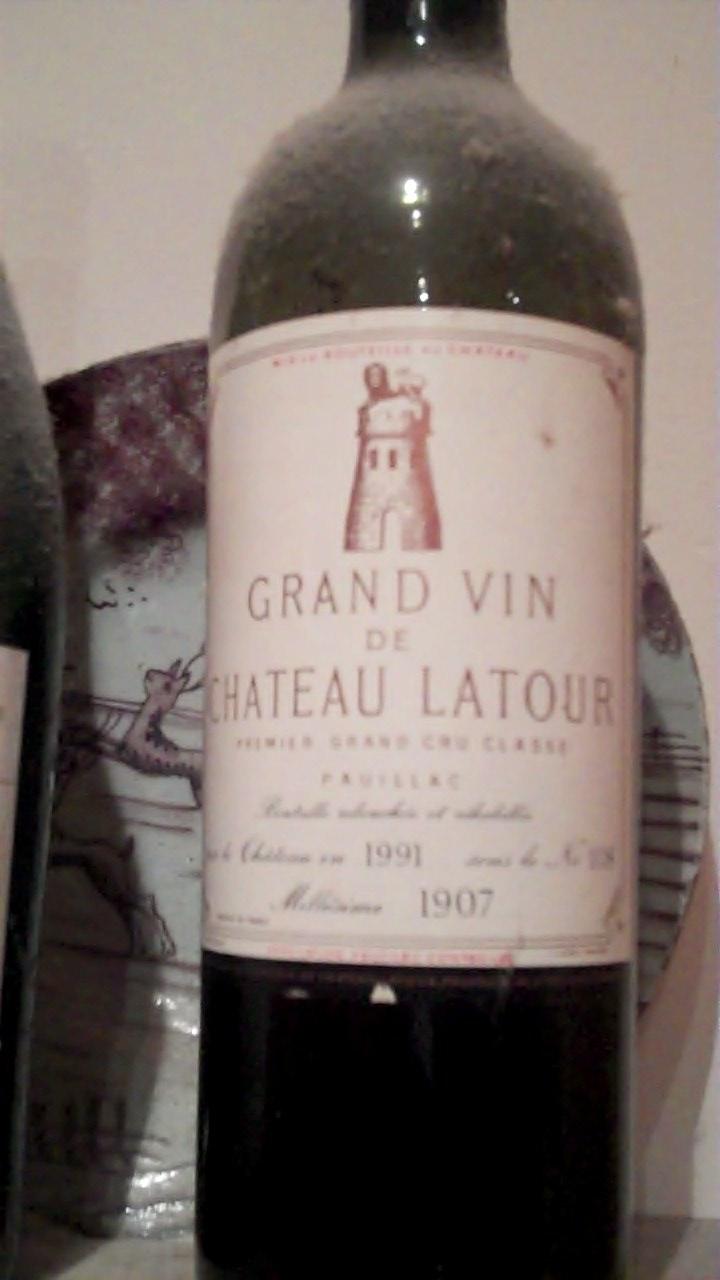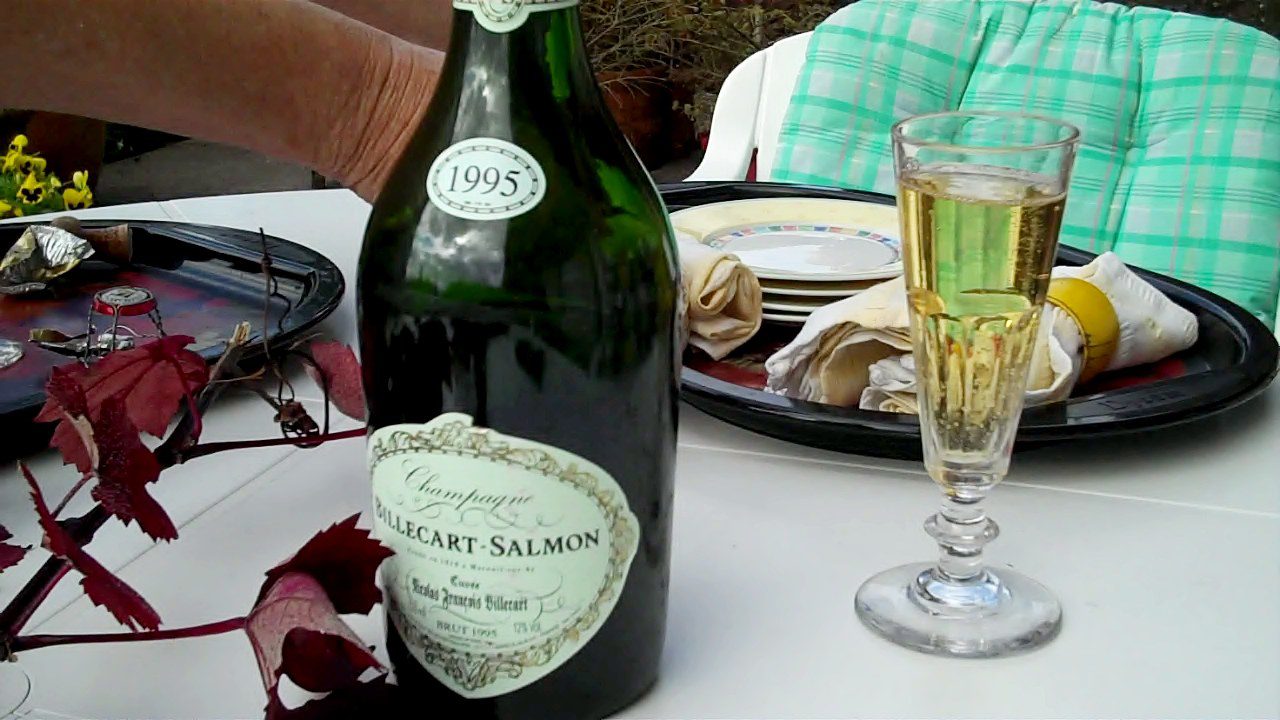 Thank you to my amazing wife Liz for suggesting, and as much to our very special trans Atlantic chums for
Thank you to my amazing wife Liz for suggesting, and as much to our very special trans Atlantic chums for  hosting our belated 50th birthday celebration in Bristol, England this past weekend. These friends organized a 40th birthday soiree in our honor back in 1999 and it did not take long for all of us to concur that 10 years of personal aging required a proper encore. After all, the ’99 version provided a good excuse to drink a birth year 1959 Latour along with a whole bunch of other vintages back to 1907 Latour that were just collecting dust in a naturally dark, damp, and catacomb-like Bristol cellar.
hosting our belated 50th birthday celebration in Bristol, England this past weekend. These friends organized a 40th birthday soiree in our honor back in 1999 and it did not take long for all of us to concur that 10 years of personal aging required a proper encore. After all, the ’99 version provided a good excuse to drink a birth year 1959 Latour along with a whole bunch of other vintages back to 1907 Latour that were just collecting dust in a naturally dark, damp, and catacomb-like Bristol cellar.
 We arrived in Bristol by train on a warm and sunny October Saturday morning and were immediately whisked out back to enjoy an Indian summer day in the terraced gardens that scale their way down a steep hill towards a river claiming the second most severe tidal rise and fall of any in the world. Not more than a couple hours after boarding our morning London train, a cork was disgorged from a bottle of 1995 Billecart-Salmon Cuvee Nicolas Francois Billecart. Snacking on a few small bowls of fresh quail eggs, olives, and fruit I looked out over the stone wall to the green hills and was
We arrived in Bristol by train on a warm and sunny October Saturday morning and were immediately whisked out back to enjoy an Indian summer day in the terraced gardens that scale their way down a steep hill towards a river claiming the second most severe tidal rise and fall of any in the world. Not more than a couple hours after boarding our morning London train, a cork was disgorged from a bottle of 1995 Billecart-Salmon Cuvee Nicolas Francois Billecart. Snacking on a few small bowls of fresh quail eggs, olives, and fruit I looked out over the stone wall to the green hills and was momentarily transported to the French countryside as I listened to the snap-crackle-pop emerge from my glass’ surface. The dozen or so years in the cellar had mellowed the wine in a way that tamed the fizz without completely losing a most pleasing tiny bubble effervescence. A distinct biscuity character was in evidence, and the wine was supple and elegant offering the very beginnings of some advanced flavoring.
momentarily transported to the French countryside as I listened to the snap-crackle-pop emerge from my glass’ surface. The dozen or so years in the cellar had mellowed the wine in a way that tamed the fizz without completely losing a most pleasing tiny bubble effervescence. A distinct biscuity character was in evidence, and the wine was supple and elegant offering the very beginnings of some advanced flavoring.
 We divided and conquered, Liz returning to the kitchen and me helping with a full cellar transporter that needed emptying after our host’s quick disappearance among the wine stocks. The carrier was laden with 2003 Hugel Pinot Gris Tradition “Hugel”, 1989 Montrachet Grand Cru Bouchard Pere et Fils, 2000 Chevalier Montrachet Henri Clerc and a 1992 Leflaive Batard Montrachet (we never managed to get to the Leflaive). The ladies needed our help carrying the freshly baked scallop pie and accompaniments to the garden before we all regrouped to try or 2nd, 3rd, and 4th wines at this mid day point.
We divided and conquered, Liz returning to the kitchen and me helping with a full cellar transporter that needed emptying after our host’s quick disappearance among the wine stocks. The carrier was laden with 2003 Hugel Pinot Gris Tradition “Hugel”, 1989 Montrachet Grand Cru Bouchard Pere et Fils, 2000 Chevalier Montrachet Henri Clerc and a 1992 Leflaive Batard Montrachet (we never managed to get to the Leflaive). The ladies needed our help carrying the freshly baked scallop pie and accompaniments to the garden before we all regrouped to try or 2nd, 3rd, and 4th wines at this mid day point.
The Alsatian Pinot Gris from Hugel was quite delicious with pear and melon intermingling with rose petals on the nose. The color was quite light, with a whitish yellowish hue. The mouth feel was rich and coating, yet smooth and easy. I was happy to be exploring this wine in accompaniment with the warm rich scallop pie following the elegance of the Billecart-Salmon.
In what appeared to be a perfect preordained order, the Burgundy was poured and I sensed we just stepped the food and wine pairing up a notch with the older Montrachet. The 1989 from Bouchard was significantly more orange than the Pinot Gris, but not the deep orange we would discover in the younger Chevalier Montrachet. It had burnt caramel and licorice on the nose (Virginia noticed Gooseberry aromas, which was news to Liz and I since neither of us ever smelled the hairy berry). The wine was silky and rich with enough acidity to provide ample structure to a highly nuanced 20-year-old Chardonnay. We loved it!
and wine pairing up a notch with the older Montrachet. The 1989 from Bouchard was significantly more orange than the Pinot Gris, but not the deep orange we would discover in the younger Chevalier Montrachet. It had burnt caramel and licorice on the nose (Virginia noticed Gooseberry aromas, which was news to Liz and I since neither of us ever smelled the hairy berry). The wine was silky and rich with enough acidity to provide ample structure to a highly nuanced 20-year-old Chardonnay. We loved it!
The 2000 Chevalier Montrachet by Henri Clerc was past its prime and disappointing. The color was deep orange but the wine was flabby and missing fruit. Still, it was not completely lost, but definitely over the hill. We were surprised this younger white Burgundy, bought on release, had such a short life in comparison to the Montrachet at twice its age. We reminded ourselves that there was still something to appreciate in this wine, that it no longer offered a classically aged profile, but there were nuances that were interesting to note, even though the wine was approaching its useful end.
Our host and hostess had paid a visit to Madeira, the island off the west coast of Portugal. While there, they tasted through a few cellars and wanted to share a couple prime examples of the Brandy fortified wine now that we were on a roll. Produced were two different bottles of 1989 D’Oliveiras; the Sercial and Malmsey. These are two of four Madeira designations indicating levels of dryness. The Sercial is driest, and had a toffee alcohol soaked nose, reminding me a bit of the Babba Rum pastries I used to crave from Ferrara’s in New York’s little Italy. The flavors and finish were dead ringers for alcohol soaked fruit cake. It was a perfect foil to the primarily local countryside cheeses we were snarfing down post meal.
Even richer, the Malmsey rings the bell for the least dry designation. The wine smelled like stewed raisins. Its flavor was reminiscent of dried candied apricots. It was silky and dangerously smooth, with a long, long warm finish.
I ranked the wines from this afternoon in this order of preference:
1995 Billecart-Salmon Cuvee Nicolas Francois Billecart
1989 Montrachet Grand Cru Bouchard Pere et Fils
1989 D’Oliveiras Malmsey
1989 D’Oliveiras Sercial
2003 Hugel Pinot Gris Tradition “Hugel”
2000 Chevalier Montrachet Henri Clerc
We vowed to walk and then maybe a zizz (napping reference in Bristol) before a 6pm decanting wake up call. We had lots of business ahead that night. More close friends were showing up for our celebration. It promised to be a great evening of new friends, wonderful food, and wines we mostly dream about.
For now, I need to think about extending my morning run regimen for just a few days.
